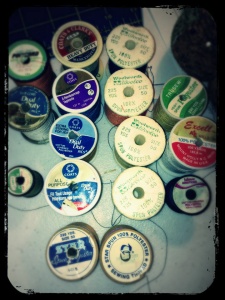My journey into sewing quickly brought me to quality and types of thread. In groups I’m a member of for beginner seamstresses, that is a super frequent question…what thread do I use? And sadly, there are those out there who have never thought about the difference and have sewn with crappy thread for years. There is more to it than you’d think, so let’s go on a Sew Jam thread journey!
I need to say that I am not a fan of, nor ever will be a fan of, major department store (both general and hobby related) brand thread. It’s cheap for a reason. Might I add that you get what you pay for, I promise. With that said, let’s make our first stop.
Types of Thread:

Cotton: Think quilting. This has little stretch and can break quite easily. It can also produce a whole lot of lint which translates into bad mojo for your machine, especially if you buy cheap. Uses: quilting, embroidery, heirloom and decorative and patchwork.
Polyester: Think everything! It is has great elasticity. It is one of the strongest fibers as well as heat resistant which means it can withstand the iron at high settings and is UV resistant. It’s quite popular because it can take on the appearance of cotton with polyester benefits or come in a nice sheen mimicking a silk look. There are 4 different types of polyester thread used in the industry. I won’t get into them here, since the differences are uses on Sergers (a different article all together), high speed industrial machines and long arm quilting machines. If you really need to know what the four are, google it! Uses: general sewing, quilting and embroidery.
Cotton-wrapped Polyester: Think all purpose. Polyester is a man made material or filament that covers cotton. Therefore it will have all the characteristics of cotton with the benefits of a stronger, smoother polyester coating. Uses: All purpose or general sewing.
Nylon: Think delicate. Nylon is very similar to polyester in that it is man made from chemicals and is quit strong (think nylon leggings!). This thread is notable for it’s strength and flexibility which is important when your thread should be slightly stronger than the fabric it is securing for durability. However, Nylon is not super UV resistant making Polyester a better thread for outdoor items and it is known to yellow over a long time period although it is rot resistant. Additional it does not absorb liquid making it popular for under arm seams or sweaty areas of a body. Uses: light to medium weight synthetic fabrics, bonded nylon for upholstery and wooly nylon for serged seams, decorative stitching and rolled hems.
Silk: Think tailoring. This is a fine strong thread for sewing silk and wool. It’s also suitable for knits due to it’s elasticity. It’s awesome for basting (although no one in their right mind would due to price … unless the garment is bridal, heirloom, etc) because silk will not leave a hole where stitched nor will it leave an indent or impression after ironing. When I said think tailoring, I meant it. This is a great natural fiber that will mold itself into the shaped tailored areas. Uses: basting on any fabric, silk, wool, and knits.
These are the very basics. When choosing your thread, you may hear some seamstresses tell you to match the fiber of the thread with the fiber of the fabric you’re stitching. I tend to put a little more thought into it, such as: cotton clothing for children in which I’d use the stronger polyester thread for construction, or a project that is going to be subjected to high heat ironing, I’d use a high heat thread. And, I may use more than one type of thread for a project! Cotton on a neckline, polyester on the seams and wooly nylon for a nice soft hem.
Ok, let’s take a break in our journey to reflect a moment. If you are a beginner, I have basically given you the ammunition you need to go out and get your thread on. Alas, I am not done. To avoid the deer-in-the-headlights look, I will end here.
In the next stop, I will cover: topstitch thread, rayon, fusible thread, metallic and other threads you may have heard of such as darning cotton. In our final and third stop, I will clue you in to what some thread terms mean.. some you may hear when reading or discussing thread, how thread is sized and and explaining the ‘finishes’ on a thread.
